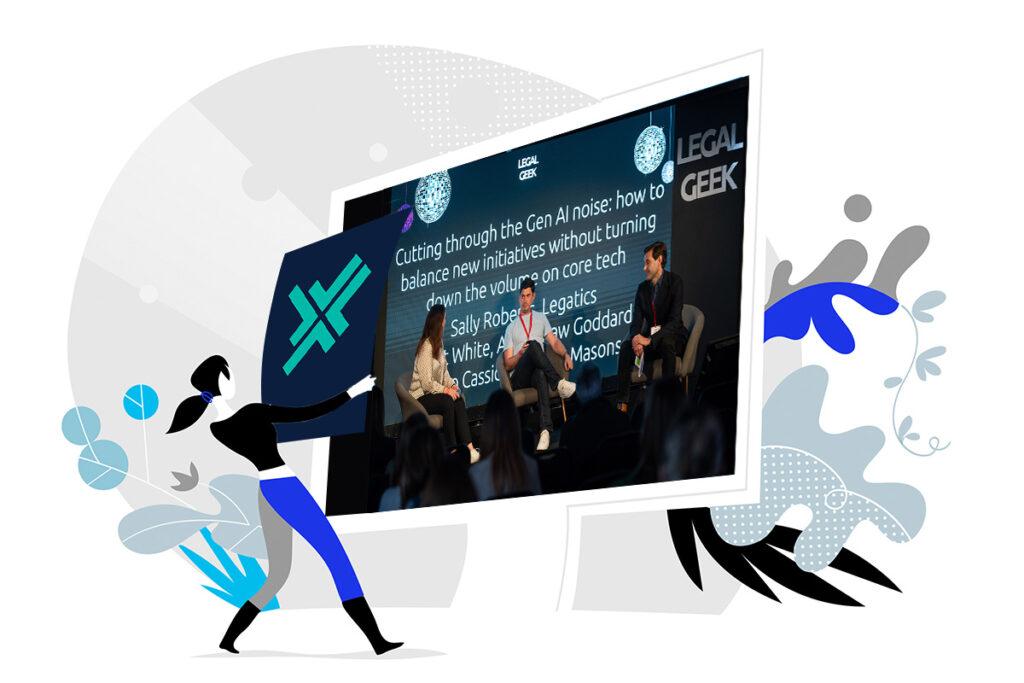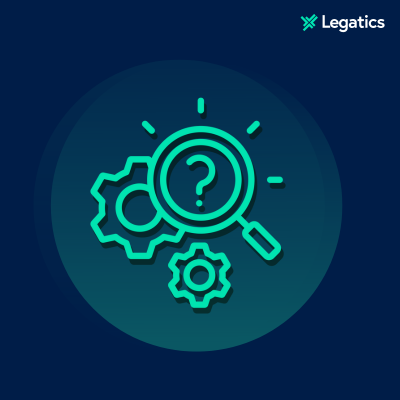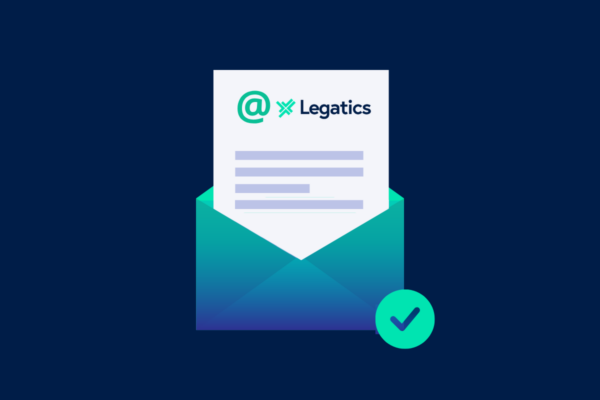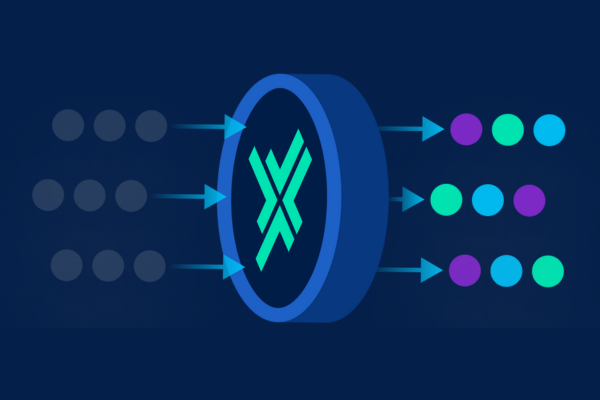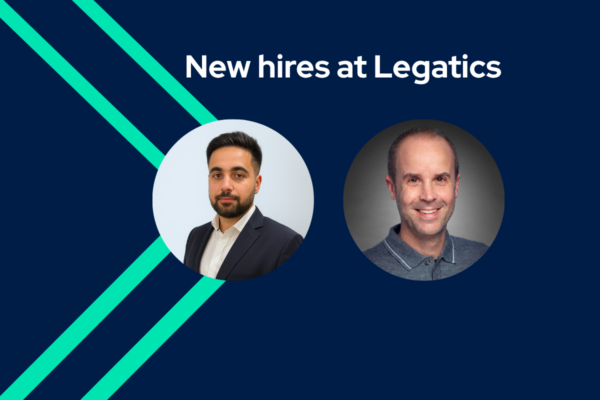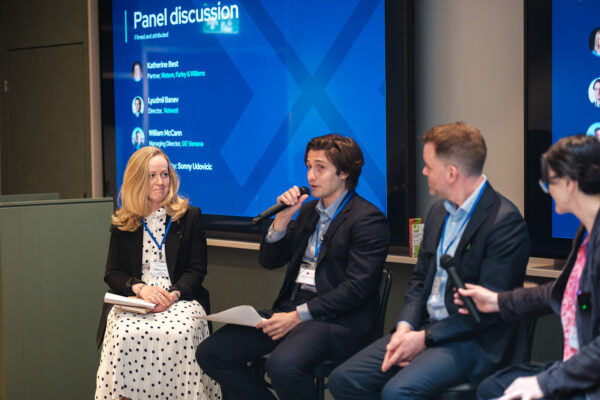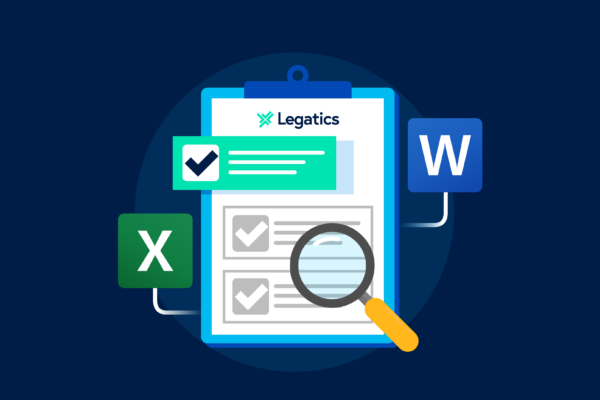We took to the stage at Legal Geek to discuss AI and how its impacting law firms!
With the buzz about AI in the legal sector at an all-time high, our Head of Customer Sally Roberts took to the stage at Legal Geek to host a panel discussion on balancing new initiatives with core legaltech. She was joined by Elliot White, Head of Innovation and Legal Tech at Addleshaw Goddard and Hugo Cassidy, Partner at Pinsent Masons.
This blog presents a few of the highlights from their enthusiastic discussion!
How much Gen AI noise exists inside law firms?
Sally Roberts, Legatics: Starting with you Hugo, could you tell us a bit about the level of noise within your firm on Gen AI at the moment?
Hugo Cassidy, Pinsent Masons: The noise level is really high. Like surround sound, it’s coming at us from all angles. Clients are asking, “How can we use it? What are you doing with it? What are the risks?”
Within our firm, we’re facing similar questions, plus, “What’s our strategy? Where will we deploy it first? Which capabilities might it replace?” It’s a lot of volume, which can sometimes distract from other projects and workflows.
Elliott White, Addleshaw Goddard: We embarked on extensive research to understand large language models and generative AI. We explored what technologies were available, and then we decided we needed hands-on experience, so we initiated trials and proofs of concept, even building our own platform.
In a way, we created that noise, but it started coming back to us as well. We’re glad we took that early start, as client and lawyer interest has been incredibly high.
How are firms resourcing their AI research?
SR: Can you tell us a little bit more about how you resourced the research that you did?
EW: We put together a very small group. We’ve also got an R&D group that does some of this. We started with that small group researching, understanding, and then we put some feelers out to the firm of whether people would be interested in testing it.
We were then inundated with 150 lawyers saying they wanted to get involved. So, we created working groups from that and started to put some of these trial technologies in their hands to help us learn and understand what’s good about it, what’s bad about it, whether it’s actually going to work, and whether they would use it essentially.
What are AI expectations?
SR: What are the fee-earners and the partners expecting you to deliver or know about with regards to all of this?
HC: Expectations are really high, and what’s been a pleasure about this is that the level of stakeholder enthusiasm around the business has been almost universal. Everyone is keen to be involved in the training sessions and wants to put forward their use cases and so on.
So, expectations are high because that level of interest wants to be rewarded with strategy progress and tools that people can start to use. And again, it’s that challenge of how do you meet that need, that excitement, whilst also keeping your eye on the ball of core technology that answers work-type needs that Gen AI doesn’t need to be applied to.
EW: They expect a lot from us in terms of what we bring to them, but actually we’re also setting that expectation back of “well, this isn’t changing, you need to be prepared”. That’s taken time and being somewhat belligerent in driving that message home and being given the opportunity to do that in different spaces and meetings within the firm.
How are firms building teams that are responsive to change?
SR: One of the things that you mentioned earlier was how you structured the teams that you have to be able to be agile and respond to these kinds of changes. Can you share a bit about that?
EW: I’d love to say we planned ahead with generative AI and we structured our team perfectly. But, you know, we are lucky to have an R&D team, so we could pivot what we were looking at in that team, take things out and say “you’re going to look at this now”.
And we started to then bring other teams into this as and when it made sense, but it meant we could then continue some of the projects and initiatives we had and not drop the BAU ball.
I’m fully aware that not everyone has that option or the size of team to do that. But what you can’t do with this sort of thing is sit there and just say “well, I don’t have time for this”. I think everyone has to make time for this. And there’s a balancing act with that.
How is AI different from other innovation projects?
HC: In a way it’s tremendously exciting because sometimes we’re tasked with taking on technology, deploying it or developing it and there’s sometimes a bit of an uphill struggle to get the momentum that you’d really like.
Here, that surround sound, that volume, that excitement means that we have engaged stakeholders. Also, the proximity of technology to users right now, in the way that people can just access open-source software, play around with it and do things that are really breathtaking in terms of the power that the individual can have without further tech support.
So yes, for me, in terms of the surround sound, the proximity, the excitement, and what the roadmap looks like in terms of capabilities, it’s very different.
[end of panel discussion]
Highlights from our ‘Cutting through the Gen AI Noise’ Panel Discussion at Legal Geek 2023
Tags:
legaltech, product update
|
Share Article
Claire Cullum, Content Manager
We took to the stage at Legal Geek to discuss AI and how it’s impacting law firms! With the buzz about AI in the legal sector at an all-time high, our Head of Customer Sally Roberts took to the stage at Legal Geek to host a panel discussion on balancing new initiatives with core legaltech. She was joined by Elliot White, Head of Innovation and Legal Tech at Addleshaw Goddard, and Hugo Cassidy, Partner at Pinsent Masons.
This blog presents a few of the highlights from their enthusiastic discussion!
How Much Gen AI Noise Exists Inside Law Firms?
Sally Roberts, Legatics: Starting with you, Hugo, could you tell us a bit about the level of noise within your firm on Gen AI at the moment?
Hugo Cassidy, Pinsent Masons: So the level of noise is really high. And to extend the metaphor, like surround sound, we’re getting it from all angles. So clients are asking us, how can we use it? What are you doing with it? What are the risks?
Within our business, we’re getting similar questions, but also what’s our strategy? Where are we going to deploy it first, which capabilities is it going to replace, and so on. So lots of volume, which can be the theme and a distraction to other projects and workstreams.
Elliott White, Addleshaw Goddard: So we embarked on a huge research task in terms of understanding large language models, generative AI and getting that foundational knowledge. And then we worked towards understanding technologies that were out there. Beyond that, we then started to think we need to get hands-on, we need to do trials, proof of concepts, and actually start building our own platform as well.
So, I guess I’m saying that we created that noise, but similarly that noise then started to come straight back. We’re really glad we took that early start because the level of interest from our clients and from our lawyers was really high.
How Are Firms Resourcing Their AI Research?
SR: Can you tell us a little bit more about how you resourced the research that you did?
EW: We put together a very small group. We’ve also got an R&D group that does some of this. We started with that small group researching, understanding, and then we put some feelers out to the firm of whether people would be interested in testing it.
We were then inundated with 150 lawyers saying they wanted to get involved. So, we created working groups from that and started to put some of these trial technologies in their hands to help us learn and understand what’s good about it, what’s bad about it, whether it’s actually going to work, and whether they would use it essentially.
What Are AI Expectations?
SR: What are the fee-earners and the partners expecting you to deliver or know about with regards to all of this?
HC: Expectations are really high, and what’s been a pleasure about this is that the level of stakeholder enthusiasm around the business has been almost universal. Everyone is keen to be involved in the training sessions and wants to put forward their use cases and so on.
So, expectations are high because that level of interest wants to be rewarded with strategy progress and tools that people can start to use. And again, it’s that challenge of how do you meet that need, that excitement, whilst also keeping your eye on the ball of core technology that answers work-type needs that Gen AI doesn’t need to be applied to.
EW: They expect a lot from us in terms of what we bring to them, but actually we’re also setting that expectation back of “well, this isn’t changing, you need to be prepared”. That’s taken time and being somewhat belligerent in driving that message home and being given the opportunity to do that in different spaces and meetings within the firm.
How Are Firms Building Teams That Are Responsive to Change?
SR: One of the things that you mentioned earlier was how you structured the teams that you have to be able to be agile and respond to these kinds of changes. Can you share a bit about that?
EW: I’d love to say we planned ahead with generative AI and we structured our team perfectly. But, you know, we are lucky to have an R&D team, so we could pivot what we were looking at in that team, take things out and say “you’re going to look at this now”.
And we started to then bring other teams into this as and when it made sense, but it meant we could then continue some of the projects and initiatives we had and not drop the BAU ball.
I’m fully aware that not everyone has that option or the size of team to do that. But what you can’t do with this sort of thing is sit there and just say “well, I don’t have time for this”. I think everyone has to make time for this. And there’s a balancing act with that.
How Is AI Different from Other Innovation Projects?
HC: In a way it’s tremendously exciting because sometimes we’re tasked with taking on technology, deploying it or developing it and there’s sometimes a bit of an uphill struggle to get the momentum that you’d really like.
Here, that surround sound, that volume, that excitement means that we have engaged stakeholders. Also, the proximity of technology to users right now, in the way that people can just access open-source software, play around with it and do things that are really breathtaking in terms of the power that the individual can have without further tech support.
So yes, for me, in terms of the surround sound, the proximity, the excitement, and what the roadmap looks like in terms of capabilities, it’s very different.
[End of Panel Discussion]
Despite the many uncertainties, the potential of AI as a tool for the legal sector is clear—as shown by this discussion and many other Legal Geek 2023 talks on this topic! To watch or listen to the “Cutting through the Gen AI Noise: How to Balance New Initiatives Without Turning Down the Noise on Core Legaltech” panel discussion in full, click here.


